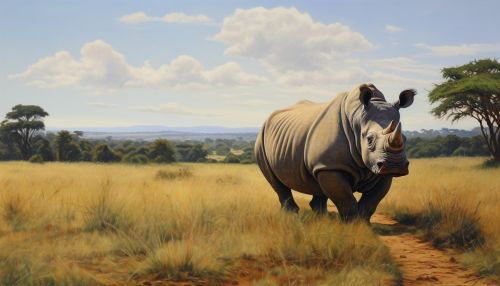Herbivory
Introduction
Herbivory is the act of consuming plant tissues by animals. This biological interaction plays a significant role in ecological systems, affecting both the evolution of plants and animals. Herbivores can range from tiny insects to large mammals, and their feeding habits can have profound impacts on the structure and function of ecosystems.


Evolution of Herbivory
The evolution of herbivory can be traced back to the first terrestrial ecosystems. Early herbivores were likely to be detritivores, consuming decaying plant material. Over time, herbivores evolved to consume fresh plant material, leading to the development of specialized adaptations such as sharp teeth for tearing plant tissues and complex digestive systems for breaking down plant cell walls.
Types of Herbivores
Herbivores can be classified into several types based on their feeding habits. These include:
- Frugivores: These herbivores primarily eat fruits. Examples include birds like parrots and mammals like bats.
- Folivores: These herbivores primarily eat leaves. Examples include insects like caterpillars and mammals like koalas.
- Granivores: These herbivores primarily eat seeds. Examples include birds like finches and mammals like squirrels.
- Nectarivores: These herbivores primarily eat nectar. Examples include birds like hummingbirds and insects like bees.
Adaptations of Herbivores
Herbivores have evolved a variety of adaptations to cope with the challenges of consuming plant material. These include:
- Dental Adaptations: Many herbivores have specialized teeth for grinding plant material. For example, cows have large, flat molars for grinding grasses.
- Digestive Adaptations: Herbivores often have complex digestive systems to break down plant material. For example, ruminants like cows and sheep have a four-chambered stomach that allows them to ferment plant material and extract nutrients.
- Behavioral Adaptations: Herbivores often exhibit specific behaviors to cope with the challenges of their diet. For example, some herbivores migrate to find new sources of food, while others have evolved to eat at specific times of the day when plant defenses are lower.
Impact on Ecosystems
Herbivores play a crucial role in shaping ecosystems. They can influence the structure of plant communities, the cycling of nutrients, and the dynamics of food webs. For example, large herbivores like elephants can significantly alter the landscape by trampling vegetation and dispersing seeds. Similarly, herbivores can influence the cycling of nutrients by consuming plant material and excreting waste.
Herbivory and Plant Defenses
Plants have evolved a variety of defenses to deter herbivores. These include physical defenses like thorns and chemical defenses like toxins. Some plants also have indirect defenses, such as attracting predators of herbivores. The interaction between herbivores and plant defenses is a key aspect of the co-evolutionary arms race between plants and herbivores.
